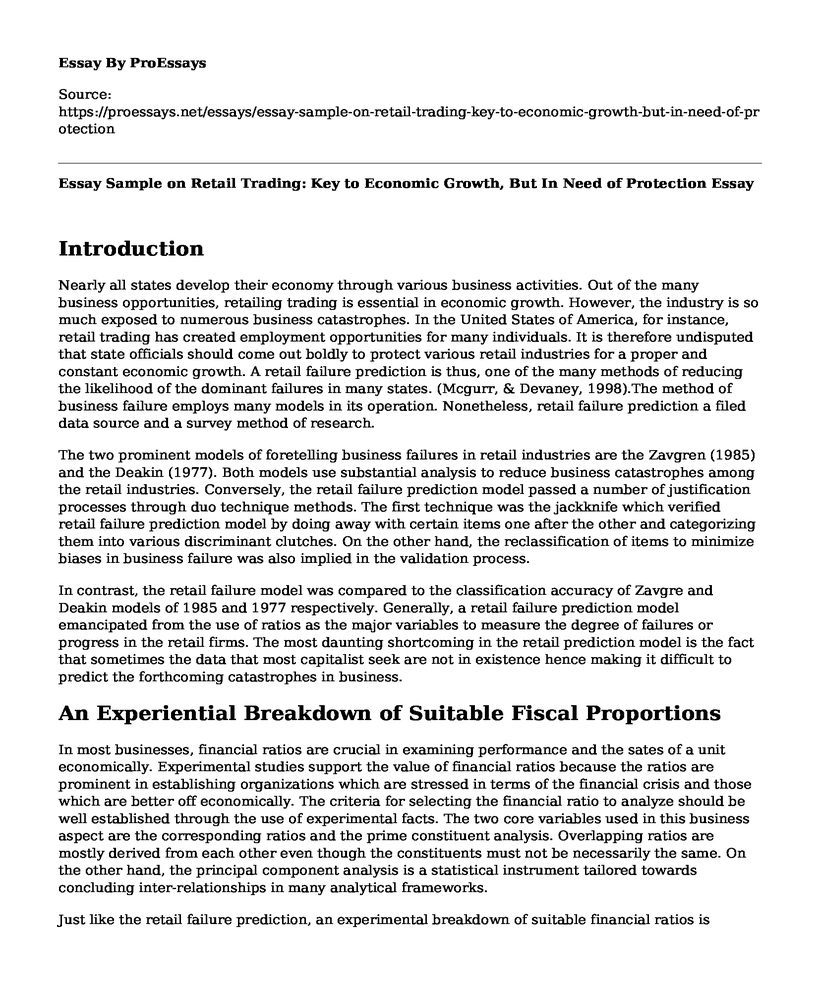Introduction
Nearly all states develop their economy through various business activities. Out of the many business opportunities, retailing trading is essential in economic growth. However, the industry is so much exposed to numerous business catastrophes. In the United States of America, for instance, retail trading has created employment opportunities for many individuals. It is therefore undisputed that state officials should come out boldly to protect various retail industries for a proper and constant economic growth. A retail failure prediction is thus, one of the many methods of reducing the likelihood of the dominant failures in many states. (Mcgurr, & Devaney, 1998).The method of business failure employs many models in its operation. Nonetheless, retail failure prediction a filed data source and a survey method of research.
The two prominent models of foretelling business failures in retail industries are the Zavgren (1985) and the Deakin (1977). Both models use substantial analysis to reduce business catastrophes among the retail industries. Conversely, the retail failure prediction model passed a number of justification processes through duo technique methods. The first technique was the jackknife which verified retail failure prediction model by doing away with certain items one after the other and categorizing them into various discriminant clutches. On the other hand, the reclassification of items to minimize biases in business failure was also implied in the validation process.
In contrast, the retail failure model was compared to the classification accuracy of Zavgre and Deakin models of 1985 and 1977 respectively. Generally, a retail failure prediction model emancipated from the use of ratios as the major variables to measure the degree of failures or progress in the retail firms. The most daunting shortcoming in the retail prediction model is the fact that sometimes the data that most capitalist seek are not in existence hence making it difficult to predict the forthcoming catastrophes in business.
An Experiential Breakdown of Suitable Fiscal Proportions
In most businesses, financial ratios are crucial in examining performance and the sates of a unit economically. Experimental studies support the value of financial ratios because the ratios are prominent in establishing organizations which are stressed in terms of the financial crisis and those which are better off economically. The criteria for selecting the financial ratio to analyze should be well established through the use of experimental facts. The two core variables used in this business aspect are the corresponding ratios and the prime constituent analysis. Overlapping ratios are mostly derived from each other even though the constituents must not be necessarily the same. On the other hand, the principal component analysis is a statistical instrument tailored towards concluding inter-relationships in many analytical frameworks.
Just like the retail failure prediction, an experimental breakdown of suitable financial ratios is critical in highlighting any form of the possibility of a firm's disaster. (Chen & Shimerda, 1981). According to the principal analysis of suitable empirical financial ratios, the proportions categorized by similar factors are said to be mostly interconnected. The high correlation of ratios in the experimental breakdown results in misleading results from the experiment. It is therefore important that only one ratio from many cases should be carefully chosen to stand for other similar ones in the statistical evaluations. The method of foreseeing organizational failures through empirical analysis of important proportions can sometimes be insufficient based on the type of ratios selected as discussed previously.
Conclusion
Conclusively, for a constant growth of economies, failures in business operations should be identified early enough to allow for proper planning to solve the shortcomings. The failures can be reduced through the adoption of the retail failure prediction methods or the empirical evaluation of important proportions.
References
Chen, K. H., & Shimerda, T. A. (1981). An empirical analysis of useful financial ratios. Financial Management, 51-60.
Mcgurr, P. T., & Devaney, S. A. (1998). A retail failure prediction model. The International Review of Retail, Distribution and Consumer Research, 8(3), 259-276.
Cite this page
Essay Sample on Retail Trading: Key to Economic Growth, But In Need of Protection. (2023, Apr 10). Retrieved from https://proessays.net/essays/essay-sample-on-retail-trading-key-to-economic-growth-but-in-need-of-protection
If you are the original author of this essay and no longer wish to have it published on the ProEssays website, please click below to request its removal:
- Why Do You Do What You Do: Walmart Company Analysis
- Essay on Target: Cheap But Fashionable Retail Giant Growing Globally
- Amazon's Remarkable Rise: From Books to Alexa - Essay Sample
- Essay Sample on Best Buy: An American Online Retail Giant Selling Thousands of Products
- Retail Mgmt E-Commerce: Strategic Planning for Continuous Comp. Adv - Essay Sample
- Essay Example on Retailers Association of India Outshines Retail Council of Canada in Building Online Followers
- Free Paper on Start an Online Business: Key Points for Retail Operations Management







